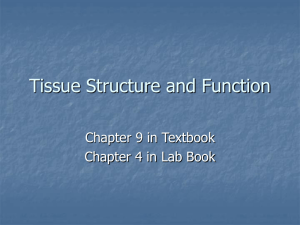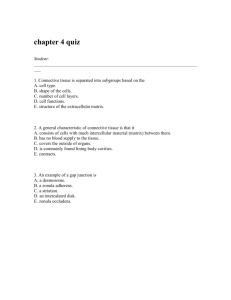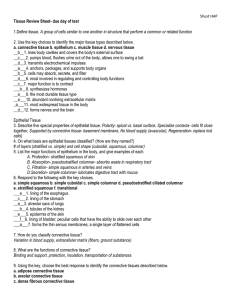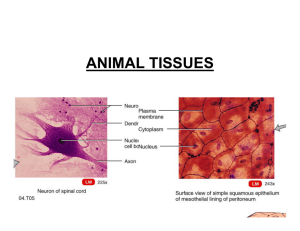Human Tissue Types - Bibb County Schools
advertisement
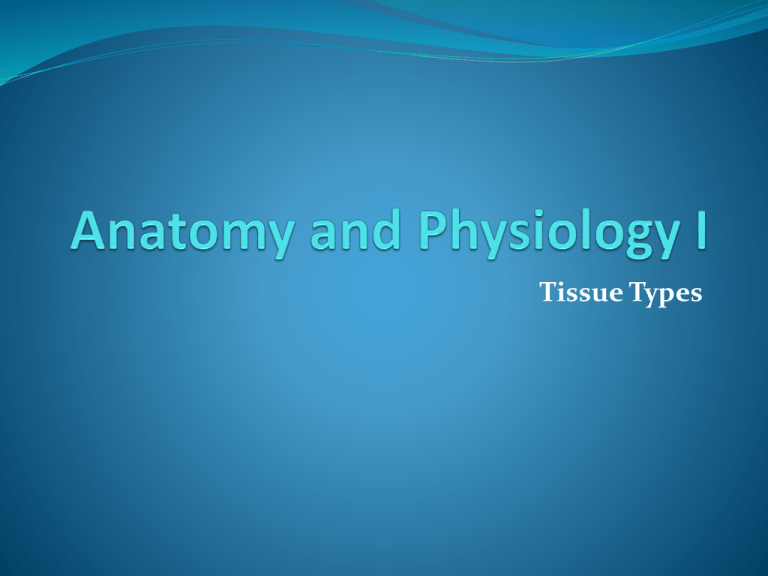
Tissue Types GPS Standards SAP1. Students will analyze anatomical structures in relationship to their physiological functions. e. Describe how structure and function are related in terms of cell and tissue types. Learning Goals By the end of this section, you will be able to: Relate structure and function to tissue types. List the four major tissue types. Describe the structure, location, and function of subcategories from the four major tissue types. Medical Terminology Define the following prefixes, suffixes, and roots: Use prefixes, suffixes, and roots to define the following: a- uni – multi – pseudo – histo epi – column – cuboid – osseous – nucleate – squamous – stratify – villi- prefix suffix avascular binucleate columnar epithelium cuboidal epithelium microvilli multinucleate peripheral protein pseudostratified osseous tissue squamous epithelium stratified squamous epithelium root Key Terms Histology: the study of tissues Tissues: groups of cells which are similar in structure and which perform common or related functions Four Basic Kinds of Tissues Epithelial Tissue Connective Tissue Muscle Tissue Nervous Tissue Epithelial Tissue Epithelial Tissue Description and Locations: Description Has one free surface (not attached to another tissue) Has a basement membrane that is attached to connective tissue Location Covers the body; has one unattached surface Lines the cavities, tubes, ducts and blood vessels inside the body Covers the organs inside body cavities Epithelial Tissue Functions: Protection from physical & chemical injury, Protection against microbial invasion, Contains receptors which respond to stimuli, Filters, secretes & reabsorbs materials and Secretes serous fluids to lubricate structures. Squamous Epithelium Simple Squamous Stratified Squamous Simple – a single layer squamous – flat Lines alveoli of lungs, which allows the passive transport of gases. Stratified – several layers Forms the epidermis of the skin Cuboidal Epithelium Cuboid Cells Simple – one cell thick Roughly cube shaped Duct Cuboid Cells Duct Line ducts in kidneys, etc, where reabsorption and secretory activities take place. Columnar Epithelium Simple – one cell thick Column shaped (long & narrow) Line digestive tract where reabsorption & secretion occurs. Pseudostratified – gives the appearance of more than one layer of columnar epithelial cells Connective Tissue Connective Tissue Description and Location: Description Most diverse group of tissue Composed of various fibers Location Everywhere - Most abundant & widely distributed tissue Connective Tissue Functions: Connects, binds and supports structures (tendons, ligaments, cartilage, etc.) Protects organs and tissues (bone) Cushions and insulates (fat) Transports substances (blood) Connective – Dense White Fibrous Strap-like, dense, white Binds bone to bone (ligaments) or muscle to bone (tendons Connective – Hyaline Cartilage Supports while providing flexibility Absorbs compression between bones in joints (articular cartilage) Holds open respiratory passages Most abundant type of cartilage in body Connective – Bone (Osseous) Tree ring-like appearance Supports & protects Mineral storage Fat storage Blood cell production Connective - Adipose Honeycomb or chickenwire appearance Stores energy (fat) Insulates Supports & protects organs Connective - Blood Only fluid connective tissue Removes wastes from cells Supplies nutrients and oxygen to cells Muscle Tissue Muscle Tissue Location: Muscle Tissue Functions: Description May be striated or smooth, branched or unbranched, cylindrical or spindle-shaped depending on type Location There are three types based on location Skeletal – associated with bones of the skeleton Smooth – found in the walls of hollow organs Cardiac – found in the heart Movement Locomotion Maintains posture Produces heat Facial expressions Pumps blood Peristalsis Muscle Tissue - Skeletal Muscle fibers (cells) long, parallel & cylindrical With many nuclei (multinucleate) Striations (cross stripes run perpendicular to the cells Produce voluntary movement Locomotion Heat Muscle Tissue - Smooth Spindle-shaped cells with central nuclei Arranged to form sheets No striations Pushes substances or objects (food, urine, babies) through passageways Involuntary control Muscle Tissue - Cardiac Branching, striated, uninucleate with special intercalated discs branches Contracts to propel blood into circulation Involuntary control Intercalated disc Nervous Tissue Nervous Tissue Description and Location: Description Large cell body that contains the nucleus, which is attached by long processes Location Main component of the nervous system, ie., brain, spinal cord & nerves. Nervous Tissue Functions: Regulates & controls body functions Generates & transmits nerve impulses Supports, insulates and protects impulse generating neurons. Nervous Tissue – Neuron Branching cells with many long processes Large central nucleus Regulates activities by transmitting impulses from one area of the body to another Resource Adapted from the Anatomy PowerPoint of J. A. Giacobbe, South Pointe High School, Phoenix, AZ To view slides of human tissue see the Central Ohio Technical College website, Human Biology Slide Review http://www.newarkcolleges.com/kponto/4081Slides/in dex.htm


